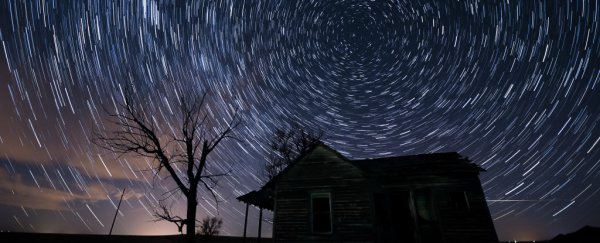We're only a couple of days into the new year, and 2017 is already putting on one hell of a show for us. This week we have the chance to see a rare comet whizz past Earth for the first time.
To make the night sky even more spectacular, one of the year's best meteor showers, the Quadrantid meteor shower, is about to peak overnight on the 3rd and 4th of January, depending on where you are in the world.
The annual meteor shower is thought to be triggered by Earth passing through the tail of rubble that follows behind the small Solar System body 2003 EH1. As these little pieces of debris and space dust burn up in Earth's atmosphere, they cause spectacular shooting stars - up to 100 every hour.
The good news: this year, the meteor shower will appear especially bright because the Moon is a waxing crescent and only partially illuminated, making the Quadrantids easier to see.
The bad news: the shower is pretty much only viewable from the Northern Hemisphere, seeing as the shooting stars appear to originate near the northern star formation, the Big Dipper.
The best time to watch is between midnight and dawn - but unlike meteor showers such as the Perseids and Geminids, which peak over a few days, the Quadrantids only has a peak viewing window of around 2 hours, and it's not entirely predictable when it'll occur.
The best estimate is that the peak will occur around January 3, 14:00 UTC.
That means those across most of North America will have the best shot of viewing before dawn on January 3, while those in Asia should look to the skies after midnight on the morning of January 4.
People in Europe are unlikely to see the peak of the shower, but, again, this time is just an estimate, so it's still worth watching the skies in the darkness before dawn over the two nights, in case you get a glimpse of the shower.
But even if you're in the Southern Hemisphere, wrong time zone, or are just struggling with overcast weather, you can still watch the shower live thanks to the Slooh online observatory live stream below:

Meteor showers are usually named after the constellation they appear to radiate from. So why is this shower called the Quadrantids? Interestingly, the shower was named after a constellation that no longer exists - Quadrans Muralis, or Mural Quadrant.
Constellations are groups of stars in our night sky that form recognisable patterns. Quadrans Muralis was described by French astronomer Jerome Lalande in 1795, and it was located between the constellations of Bootes the Hersman and Draco the Dragon. The meteor shower was officially named an annual shower in 1839 and named after the constellation, where it appeared to come from.
But this was more than 100 years before the International Astronomical Union made its official list of 88 modern constellations. This list was decided upon by an international team of astronomers who met in Rome in May 1922, and Quandrans Muralis didn't make the list.
Even today, a new constellation has to be proposed to the International Astronomical Union before it becomes official.
But the Quadrantids meteor shower retains the name of the long-gone constellation, and it's also a pretty incredible way to see in the new year.
So go and find somewhere far from the city lights, give yourself 20 minutes to get your eyes used to the dark, and enjoy taking some time out to watch our Universe put on a show.
